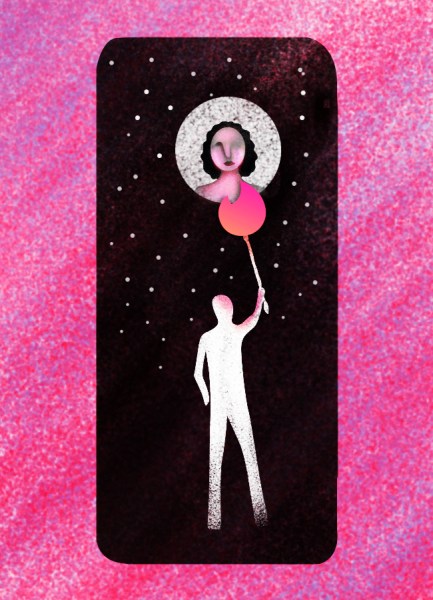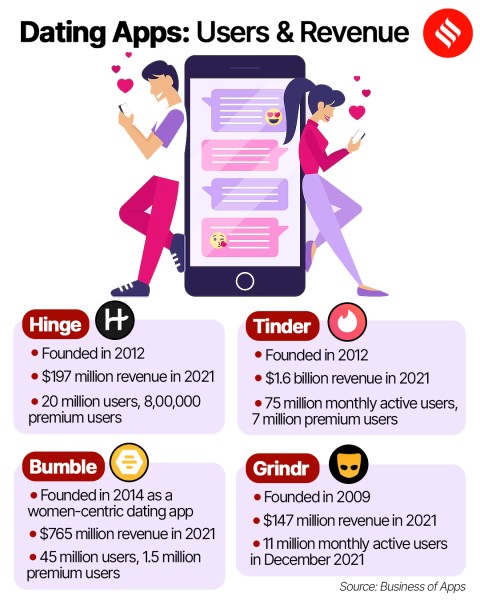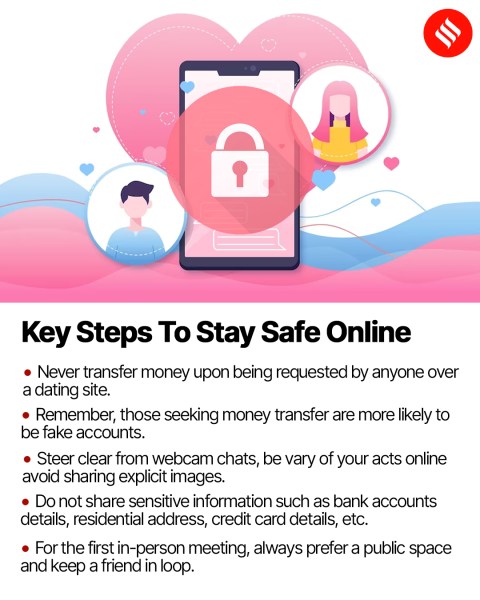More men and women are signing up online to find love than ever before. This comes with its own set of advantages, problems and even quirks. While the increasing number gives a larger field to choose from, it also increases the number of non-serious players to negotiate.
And, then, there is also the question of perseverance. Ask Vaishakh Gulab, 29, a software engineer from Pune. Gulab began using Tinder in 2018, but uninstalled it after a few unsuccessful attempts. He also tried three other options, only to later get back again on Tinder. In 2019, he found a match and was planning to meet the girl. But with the outbreak of Covid-19, that relationship fell off. In October 2020, he matched with Shilpa, a trademark analyst who is now his fiancee.
“Dating applications can get unwieldy and demotivating at times, however, they can also spring surprises,” says Gulab. He feels they are a boon for men who find it awkward to strike up a conversation with women in real life. That sentiment is widely shared. A recent survey by dating application QuackQuack said 29 per cent of users above 35 years feel these applications are the best conduit for introverts as it offers them a more comfortable space to express their feelings at their own pace.
Gulab, like millions of young Indians, was actively engaged with multiple dating applications. Beyond what the algos foretell, how do these busy professionals know when they have a real connection?
Dating apps have interfaces that act more like lead generators, as they offer a vast pool of potential matches to pick from. After two people match on an app, it’s up to them to start a conversation and take it to the next level – a real-world meeting. While the risks of running into the wrong person, or even the occasional fraud, is high, users seem to have accepted it as an inevitable part of the online dating experience. And regardless of such risks, these apps have managed to instill trust.
Tinder, women-first platform Bumble, and Hinge are among the most popular dating apps in the world. However, every few months a new application makes it to the spectrum. This increasing volume of applications offers greater freedom of choice to people of all age groups, sexual orientations, and belief systems – essentially more chances of finding love.
“Internet dating is popular, and these dating apps have fueled the trend. While technology has certainly played a role, societal roles have also shifted and given way to more freedom, self-expression, and experimentation in getting to know a potential partner through apps,” says Dr Sarika Boora, a clinical psychologist in Delhi.
Advertisement
 Today, most dating applications have interfaces that act more like lead generators, as they offer a vast pool of potential matches to pick from. After two people match on an app, it’s up to them to start a conversation and take it to the next level – a real-world meeting. (Image: Vishnu Ram)
Today, most dating applications have interfaces that act more like lead generators, as they offer a vast pool of potential matches to pick from. After two people match on an app, it’s up to them to start a conversation and take it to the next level – a real-world meeting. (Image: Vishnu Ram)
Emerging Indian apps
In India, Tinder was introduced in 2016 and has since been witnessing a steady growth in its user base and revenues. Although international dating applications continue to be the undisputed leaders in the domestic market, India has its own share of homegrown applications that are gradually consolidating their presence. Indian entrepreneurs too are capitalising on the exploding interest among Gen Z who constitute the major consumer base of modern dating apps in India.
The revenue in the online dating segment in India was projected to reach $559 million in 2022 based on a report from Statista.com. The same report also projected the growth of the segment up to $873 million by 2026. Prominent dating apps in India, as of now include, Aisle and its vernacular dating apps, FRND, HiHi, Woo, GoGaga, etc.
Each of these apps have their own USPs. GoGaga lets users find friends of friends for dating, the concept essentially involves friends assisting users in finding a dating partner. Woo, which claims to be a woman-first platform, enables women to make in-app calls without revealing their contact information. HiHi suggests a variety of topics to its users to strike up a conversation with potential partners, on the other hand FRND attempts to build one-one-connections via livestreams.
Advertisement
Best of both worlds
The launch of Tinder in India changed how many young Indians perceived romance and courtship. Also launched around the same time, Indian dating app Aisle attempted to strike a balance between traditional matrimonial sites and modern dating applications. The makers of the application aspire to be one of the leading Indian dating apps. However, they have been categorical in weeding out any semblance of a similarity with their western counterparts.
Until the launch of Aisle, more or less every matrimonial portal was seen as a pit stop for parents of single youths to meet each other to initiate an alliance. Able Joseph, the founder of Aisle, says millennials changed the dynamics. “When we arrived there was no other dating application that was claiming the digital space in India. Before 2014, almost all apps had faceless and nameless profiles, so we have been trying to be authentic and create experiences for singles. Building the trust factor was paramount,” says Joseph.
Today, Aisle has moved beyond its flagship application, has introduced dating apps in regional languages, and has a community of over 15 million users across its apps. Arike in Malayalam, Anbe in Tamil, Neetho in Telugu and Neene in Kannada are Aisle’s regional offerings, while the recently launched Jalebi app is focused on offering Gen Z a safe environment to meet the right people.
Not all on dating apps seek love
By popular definition, dating applications are a medium to find potential partners. But it doesn’t always work that way. These applications have also been giving new meanings to relationships. A sizable number of users seem to be on them just to make connections, just someone to talk to, with no expectations attached.
“We have seen singles to be incredibly intentional in both whom they choose to date and how they choose to date…Young daters have also been looking for casual activities and shared experiences to get to know each other and make their first dates count,” explains Aahana Dhar, Director of Communications for Tinder India.
Advertisement
What changed the dating experience?
Online dating has been in existence since the birth of the Internet. Modern apps took its acceptance to newer heights. Over the years, online dating turned into a lucrative billion-dollar industry, with legacy company Match Group that owns Tinder, Hinge and OKCupid being the biggest player.
According to Satista.com, the online dating segment is tipped to reach $3.01 billion in 2023. These apps have become the most common way for people around the world to meet. Several studies in recent times have shown a significant number of couples admitting that they met first on an app or a website.
Advertisement
Tinder, which has clocked over $2 billion in revenues in 2022 alone, has been witnessing a phenomenal rise in its growth and worldwide adoption in the last decade. This increase has been attributed to generational differences, with millennials believed to be more tech savvy and open to experimentation.
Experts feel the increasing use of online dating is also due to how smartphones are streamlining location-based apps and user experiences, something which web applications on PCs never could. Many attribute gamification of dating apps as one of the keys to attracting more users. This fusion of game design elements into real world activities boosts engagement and retention. From swiping left or right, to earning points and collectibles, online dating applications are making it more fun for users.
Advertisement
 Tinder, Bumble, and Hinge are among the most popular dating apps in the world, however, every few months a new application makes it to the spectrum. (Graphics: Abhishek Mitra)
Tinder, Bumble, and Hinge are among the most popular dating apps in the world, however, every few months a new application makes it to the spectrum. (Graphics: Abhishek Mitra)
Simplifying selection
In the early 2000s, OKcupid, eHarmony and Match.com created waves after they offered to help users narrow down the dating pool. To some extent, it eased the burden of finding the right match. However, users were still required to fill in numerous questionnaires during sign-up to offer insights about their lifestyle and preferences. These set of questions made the process laborious. They also led to choice overload. Some of the sites ended up as virtual replicas of traditional matrimonial classifieds.
In 2012, Tinder took the online dating world by storm by introducing gamification. It swapped the tedious and thorough selection process with a fun user experience where potential partners were displayed like cards in a deck. Users were encouraged to instinctively pick a match without any emotional baggage. They could simply swipe right or left to like or dislike someone.
This new mode of swiping transformed online dating. Tinder also played on the number of users, emphasising more on quantity than quality.
More apps and the problem of plenty
Today, swiping on dating apps is as much fun as a game. When you find a match, the app celebrates with celebratory animation and confetti. It can also get addictive, as the more people you match, the brighter your prospects, and the deeper you get into the application. After the phenomenal success of Tinder, numerous apps followed suit and embedded similar interfaces to offer greater user experience. Hinge offered a mix of the conventional questionnaire and the modern-day gamified interface.
At present, most apps offer an identical interface and rely heavily on algorithms to help connect potential matches. Most of them offer similar paid features – especially premium subscriptions to maximise visibility and thereby increase one’s options.
In this cacophony, one of the biggest social media giants, Meta, too tried its hand. Facebook’s digital dating subsidiary, which is integrated with its social media app, though failed to gather steam when compared to its contemporaries.
In 2022, the concept of the metaverse gained momentum and virtual dating became a possibility. Several VR dating apps took form. Nevermet, a VR dating app, lets users connect sans the usual pictures and videos. It allowed users to create their avatars and set up virtual dates with those they matched.
The grey areas
Gamification may have made online dating more fun, but there is a flipside. Experts have been warning about the psychological after-effects of online dating. The fact that one is being evaluated on their external appearance may impact self-esteem and confidence and may make some feel objectified. Emotionally vulnerable individuals seeking external validation are more likely to get impacted.
“To a great extent, success in online dating greatly depends on one’s appearance. So it can be a frustrating experience for some, and may lead to body image issues,” says Dr Sarika Boora. “It also leads to poor self-esteem because of increased potential dismissals and ghosting. Depending on the type of experience faced, this often turns into anxiety and depression.”
Fake profiles on dating apps lead to misplaced attachments, which can cause trust issues and emotional distress. There is also the problem of online predators.
Bumble, launched in 2018 in India, offers a feature where women can use the first name to create a profile and share their full names with connections only when they are ready. The company says this prevents them from being found on other platforms. Interestingly, Bumble was also one of the first applications to use AI for photo verification.
“We try to provide them with an experience free from hate, aggression or bullying. Bumble has a robust Block and Report feature. We do not hesitate to permanently remove perpetrators from our platform,” says a Bumble spokesperson.
Love for all
One of the key factors that lead to the widespread adoption of dating applications is their inclusivity. Dating apps are including more gender options – other than the conventional binary of male and female. They allow users to describe their gender identity in their own terms, opening more opportunities for transgender and non-binary users.
Members of the LGBTQ+ communities were still marginalised on dating sites till Planet Romeo was launched in the early 2000s. “As years passed, more applications such as Grindr, let users set their preferences. This certainly led to greater freedom, but many members were also exposed to the dark side of gay dating apps,” says Daisy, a transgender influencer. Almost all dating applications today let users set their preferred gender and sexual orientation.
Apart from fostering inclusivity, dating apps are also making the young challenge traditional gender stereotypes. In 2022, three in four (74 per cent) men on Bumble said they have closely examined their behaviour more than ever and that they have a clear understanding of toxic masculinity; 47 per cent men indicated that they are actively challenging stereotypes; 29 per cent now openly speak about their emotions with male friends; over 52 per cent men agreed that breaking gender roles in dating and relationships have been beneficial to them.
Other side of the fence
Dating applications may bridge cultural barriers, but they are still vulnerable to scams. For premium subscribers, many of them offer better viewing options and some safety net. Some apps recommend users to try the in-built messaging application before switching over to other features that would require them to share their contact information or location details. However, no app guarantees 100 per cent safety online.
A February 2022 report in The Hindustan Times said as many as 50 senior executives, including CEOs, fell prey to honeytraps on dating application Grindr. There have also been numerous incidents where users were swindled, cheated, subjected to physical assault, or even murdered by someone they got in touch via a dating application.
 Dating applications also make many vulnerable to scams. Practising caution and being discerning about who you engage with is key. (Graphics: Abhishek Mitra)
Dating applications also make many vulnerable to scams. Practising caution and being discerning about who you engage with is key. (Graphics: Abhishek Mitra)
Perpetrators of such crimes targeted victims through the dating applications. After the initial casual exchanges, the victims are trapped using false promises and are later forced into making payments. The abusers usually threaten and blackmail using intimate pictures of the victim. Considering the stigma attached to open expression of sexuality, users are hesitant to report such abuses.
“There are two kinds of users of online dating applications. Some use it for casual connections, while some use it to find serious relationships. There are risks involved either way and we come across numerous such cases from dating apps as well as from matrimonial websites,” says Prashant Gautam, DCP, IFSO Special Cell – Delhi Police.
Gautam reveals that a large number of users of dating apps who fall into such traps are hesitant to report these cases to the police. “We encourage more people to report incidents of cheating and misbehaviour online. The more these cases are reported, the more we can assess such patterns and help people and prevent these instances in the future,” he says.
Empowering users
Considering the spate of untoward events faced by users, more and more apps are working towards providing appropriate tools and safety features. Bumble offers a Block + Report tool making it easier for the users to report any behaviour that makes them feel uncomfortable. Besides, features such as photo verification, in-app audio and video calls reduce the instances where users have to reveal their personal details.
What lies ahead for dating apps in 2023? Indians from tier 2 and tier 3 cities, including women, are increasingly taking to dating apps to determine dating choices. A recent study by Bumble showed 72 per cent of respondents believing that it is possible to fall in love online with someone whom they have never met. About 45 per cent felt that online dating is the normal. As many as 81 per cent of Indians feel optimistic about dating in 2023.
“Today, the need to meet expectations and an unwillingness to compromise is prevalent in most relationships. Moreover, live-in relationships are increasingly becoming common and this has led to dating applications becoming more popular,” says Dr Manju Mehta, former Professor of Clinical Psychology at All India Institute of Medical Sciences (AIIMS).
The advent of AI-backed technologies is giving ample hope to online dating companies. “Companies can optimise user verification by the use of AI. It can be used to understand patterns within chats and preferences of users to ward off bad actors early on,” says Able Joseph.
The uses may not begin or end with the weeding out of bad actors. AI and Machine learning could offer users a more personalised set of options based on their likes and dislikes. Bots could increasingly suggest what a match made in heaven looks like.
"Love" - Google News
February 28, 2023 at 04:16PM
https://ift.tt/VpgOEKs
Love in the time of algorithms: How dating apps have evolved in 2023 - The Indian Express
"Love" - Google News
https://ift.tt/nyGtqmA
https://ift.tt/15QalEp
Bagikan Berita Ini














0 Response to "Love in the time of algorithms: How dating apps have evolved in 2023 - The Indian Express"
Post a Comment